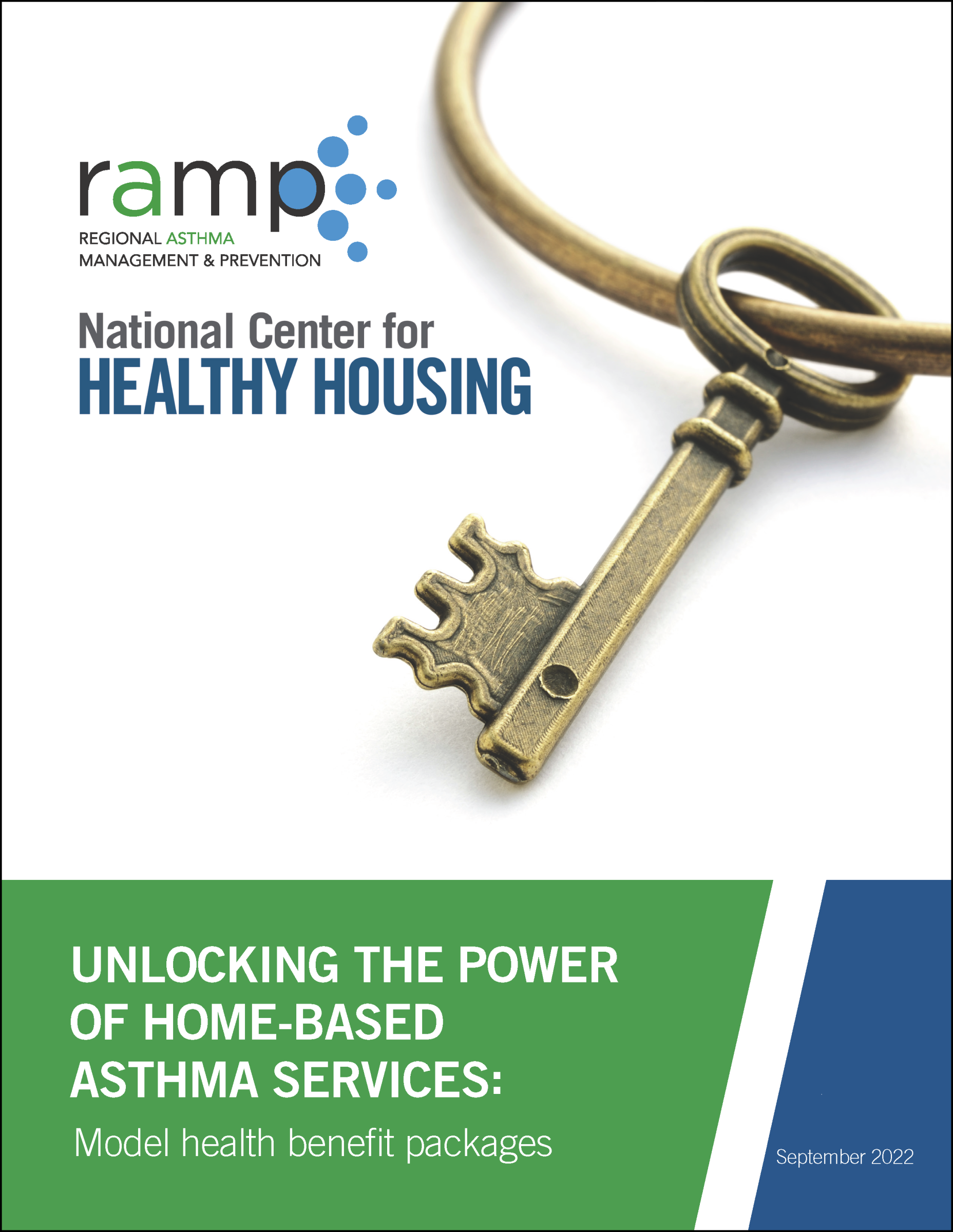Building Sustainable Asthma Home Visiting Services: We Have Resources to Help!
by Laura Fudala
It’s that time of year again! In each of the last two Octobers (2021 and 2022), we celebrated National Indoor Air Quality Awareness Month and updated you on some of the exciting work we at the National Center for Healthy Housing (NCHH) and Regional Asthma Management and Prevention (RAMP) were implementing to reduce indoor air risks. As we move into our third year under cooperative agreements with the U.S. Environmental Protection Agency (EPA), we’d like to highlight some of the new tools we’ve developed together, ask for your input on how they could be improved, and learn what else you need.
All part of a broader program, Building Systems to Sustain Home-Based Asthma Services, which offers a wide range of tools, resources, and tailored, no-cost technical assistance, here are four of the key joint resources we’ve released over the last 13 months:
- Unlocking the Power of Home-Based Asthma Services: Model Health Benefit Packages.
 This new tool from RAMP and NCHH is aimed at equipping managed care organizations (MCOs) or other healthcare payers with information they need to improve asthma management among their enrollees by ensuring the provision of asthma home visiting services. In September 2022, we published this tool to equip managed care organizations (MCOs) or other healthcare payers with the information they need to improve asthma management among their enrollees by ensuring the provision of asthma home visiting services. This resource describes the scope, staffing, and services associated with home-based asthma services that identify and address environmental asthma triggers in the home environment. The tool includes tiers of services (e.g., from a very basic set of services to more premium sets of services) to provide a range of options for payers at different levels of readiness to provide home-based asthma services and includes recommendations to support action from a range of critical stakeholders.
This new tool from RAMP and NCHH is aimed at equipping managed care organizations (MCOs) or other healthcare payers with information they need to improve asthma management among their enrollees by ensuring the provision of asthma home visiting services. In September 2022, we published this tool to equip managed care organizations (MCOs) or other healthcare payers with the information they need to improve asthma management among their enrollees by ensuring the provision of asthma home visiting services. This resource describes the scope, staffing, and services associated with home-based asthma services that identify and address environmental asthma triggers in the home environment. The tool includes tiers of services (e.g., from a very basic set of services to more premium sets of services) to provide a range of options for payers at different levels of readiness to provide home-based asthma services and includes recommendations to support action from a range of critical stakeholders. - Incorporating Virtual Visits into Home-Based Asthma Services. In December 2022, we launched a new module in our e-learning course designed to support students in considering and/or implementing virtual asthma home visiting services. It helps think through the many reasons to consider incorporating a virtual aspect to existing home-based asthma services (e.g., geographic reach, client preference, safety concerns, scheduling difficulties, workforce shortages, budget challenges, and more), and also discusses a range of issues that might be encountered (e.g., combining virtual and in-person visits, adjusting current staffing models, Communicating with clinical providers and referring clients into the program, the pros and cons of different technologies and approaches to virtual visits, and more).
- Building Healthy Indoor Environments with Healthcare. In March 2023, we published a conversation between Kate Hastings, a senior technical advisor to the National Center for Healthy Housing and leader in environmental health and healthcare policy for children, and Joel Ervice, the Associate Director of RAMP, a program of the Public Health Institute. In their conversation, Kate and Joel focus on opportunities nationwide for building healthy indoor environments with healthcare partners. They discuss how zip code can determine health destiny and explore policy change in healthcare that invites health, housing, and energy programs to invest in home environments with healthcare partners to improve health while reducing housing and environmental risks.
- Roadmap to Sustainable Asthma Home Visiting. In July 2023, we released an interactive roadmap tool to support the development of asthma home visiting services. The Roadmap is designed to guide change agents through a wide range of issues, including staffing types, client eligibility, costs, and more. The Roadmap recognizes and relies upon local organizational strengths, knowledge of the community, and unique opportunities, each of which may affect a program’s path. We’ve marked nine primary waypoints along the map and have highlighted one possible route as an example for those who want a premade path. However, users are able to rearrange the nine waypoints into whatever order they prefer to create a route that best fits where they are and where they still need to go.
Get Started
If you haven’t already seen these new resources, take a moment to visit the links embedded above and check them out today!
If you have already seen one or more of these new resources, take a moment to help us improve the tool(s) and let us know what other sorts of resources and tools would be useful for us to consider developing to support your work. Complete this extremely short survey to share your feedback and help influence our next steps.
Either way, note that NCHH and RAMP offer customized, no-cost technical assistance and support that can help you translate the information in these tools into concrete actions that achieve cross-sector partnerships and put sustainable, systems-level policies and programs in place. Email us at askanexpert@nchh.org or TA@rampasthma.org to learn more today!
Let Us Help
Do you have a success story to share about how you are working to improve indoor air quality in your community? Are you working through a challenge or next step related to one of the many facets of building sustainable systems to address radon, provide home-based asthma services, and/or conduct comprehensive indoor air risk reduction? We can amplify your success, share feedback, provide successful peer examples, or even just be a friendly ear. Visit Building Systems to Improve Indoor Air Quality and Building Systems to Sustain Home-Based Asthma Services to learn more about NCHH’s indoor air quality projects or contact us today to learn more about how we can celebrate where you are now and help you get to where you want to be.
 Laura Fudala, project manager, joined NCHH in January 2014 as a project coordinator to provide a wide variety of coordination, research, writing, and support functions on multiple NCHH projects. She currently manages a New York State Department of Health contract and an EPA cooperative agreement that together provide coordination, evaluation, technical, training, and/or programmatic support for healthy homes stakeholders such as the New York State Childhood Lead Poisoning Primary Prevention Program and those working to support the launch and growth of large-scale, evidence-based, sustainable asthma home visiting programs.
Laura Fudala, project manager, joined NCHH in January 2014 as a project coordinator to provide a wide variety of coordination, research, writing, and support functions on multiple NCHH projects. She currently manages a New York State Department of Health contract and an EPA cooperative agreement that together provide coordination, evaluation, technical, training, and/or programmatic support for healthy homes stakeholders such as the New York State Childhood Lead Poisoning Primary Prevention Program and those working to support the launch and growth of large-scale, evidence-based, sustainable asthma home visiting programs.